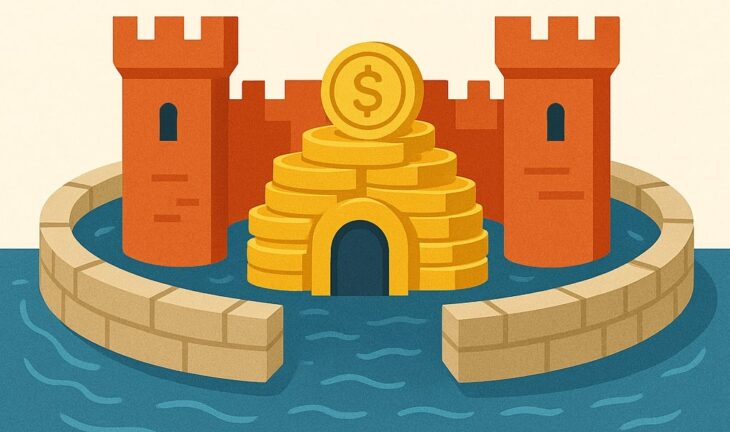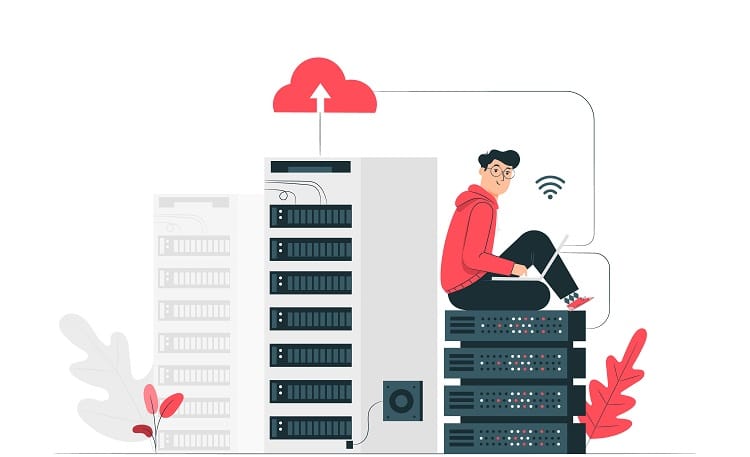A financial or economic moat refers to a durable advantage that shields a business or personal financial situation against competitive or external threats.
Warren Buffett popularized the term to emphasize the value of protective barriers that are difficult to replicate. In today’s fast-paced world where innovation and disruption emerge daily, such protection is critical.
Moats help companies and individuals remain financially strong and strategically ahead, preserving value even in volatile conditions.
Table of Contents
ToggleTypes of Financial/Economic Moats
Financial moats serve as barriers that make it difficult for others to erode your position, either in a competitive business context or within your personal finances.
These moats come in various forms and serve different purposes.
Business moats help companies maintain dominance and profitability, while personal financial moats shield individuals and households from economic shocks.
Below is an expanded breakdown, including key examples and bullet points for clarity.
Business Moats
Business moats protect companies from competitors by creating strategic advantages that are hard to replicate.
They enable companies to maintain market share, pricing power, and long-term profitability.
Here are some of the most recognized types of business moats.
Cost Advantage

Lower operational costs allow companies to sell at lower prices while still earning a profit. This cost efficiency makes it hard for newer or smaller players to compete.
Amazon utilizes massive economies of scale to undercut pricing and control a vast logistics network, which keeps costs down.
Key Points:
- Lower cost per unit due to scale
- Strong supplier relationships
- Efficient logistics and automation
TimveroOS exemplifies how fintech solutions can create both a cost and innovation moat.
By automating loan origination, underwriting, and servicing through a customizable AI-powered platform, TimveroOS enables financial institutions to launch new lending products quickly, reduce manual processes, and increase profitability.
Network Effects
Platforms gain value as more people use them. Growth of user base not only increases utility but also raises switching costs and user loyalty.
Facebook and Airbnb gain value with every additional user, improving reach and data accuracy.
Key Points:
- Enhanced user experience with more participants
- Increased platform stickiness
- Data accumulation that sharpens service delivery
Switching Costs

When leaving a product or service creates inconvenience or added expense, users are more likely to stay. This creates a protective barrier against competitors.
Apple’s ecosystem ties together hardware, software, and services, discouraging users from switching due to data loss, app incompatibility, or device learning curves.
Key Points:
- High time investment to switch
- Risk of losing customized setups or features
- Incompatibility with competing systems
Intangible Assets
Some assets cannot be easily replicated or purchased. These include strong brands, patents, trademarks, or regulatory approvals.
Coca-Cola’s brand has a global footprint built over decades, and Nike’s swoosh carries value that is instantly recognizable.
Key Points:
- Brand loyalty leads to repeated purchases
- Legal protection of innovations and logos
- Emotional or cultural connections with the brand
Economies of Scale
Larger companies can produce more at a lower cost per unit. This scale advantage can push out smaller firms that can’t compete on pricing.
Walmart leverages its volume purchasing to offer lower prices, crowding out small retailers.
Key Points:
- Reduced input costs through bulk buying
- Fixed costs spread over larger output
- Streamlined operations and workforce
Government or Regulatory Moats
Government policies and legal restrictions can act as natural protectors. Companies benefiting from exclusive licenses or heavy regulations face fewer competitors.
Electric utility providers often operate without competition due to public policy and infrastructure control.
Key Points:
- Exclusive operational rights
- Barriers to new entrants via complex licensing
- Political and legal shielding
Personal Financial Moats
Individuals, just like companies, can create financial barriers that protect against life’s economic shocks.
These personal moats ensure stability, continuity, and long-term well-being even when setbacks occur. Below are some of the essential components.
Emergency Funds

Readily accessible savings are the first line of defense when income stops or sudden expenses arise. Emergency funds reduce the need for high-interest debt and give breathing room during job loss or health issues.
Key Points:
- Should cover 3 to 6 months of expenses
- Stored in liquid, low-risk accounts
- Helps avoid credit card dependence
Disability Insurance
Loss of income due to injury or illness can derail financial plans. Disability insurance provides monthly payments when one can no longer work, supporting ongoing bills and obligations.
Key Points:
- Replaces a portion of income
- Can be employer-provided or private
- Protects against long-term setbacks
Life Insurance
Premature death can leave dependents financially exposed. Life insurance ensures family members are not burdened with debts or living expenses without support.
Key Points:
- Income replacement for family
- Pays off debts or mortgage
- Funds future education or care needs
Asset Protection Strategies
Lawsuits, accidents, or creditor claims can put personal assets at risk. Structures such as trusts or LLCs legally insulate wealth, ensuring protection for heirs and retirement funds.
Key Points:
- Reduces personal liability
- Shields investment or business assets
- Essential for professionals in high-risk fields
Investment Diversification & Risk Management
Spreading investments across categories minimizes exposure to volatility. Risk management avoids overconcentration, while diversification sustains long-term gains.
Key Points:
- Allocates capital across asset classes
- Reduces volatility and downside impact
- Emphasizes consistent growth over quick wins
Narrow vs. Wide Moats
Financial and economic moats are not all created equal. Some offer a fleeting advantage that may boost short-term growth but quickly fade when competitors catch up.
Others create a strong, defensible position that can protect profits and market share for years. Distinguishing between narrow and wide moats is essential when assessing the strength of a business strategy or personal financial plan.
The scope and sustainability of an advantage determine the kind of moat being built, and the level of protection it provides during economic shifts or competitive pressures.
Narrow Moats

Narrow moats offer limited protection. These advantages often come from innovation, market timing, or emerging trends that give a temporary edge.
Such advantages attract competition and imitation, leading to erosion. Businesses or individuals benefiting from narrow moats must constantly evolve or risk losing their lead.
Here are key characteristics of narrow moats:
- Often linked to trends, fads, or timing.
- Competitors replicate products, services, or methods quickly.
- New players can enter the market without significant resources.
- Income or returns can fluctuate due to lack of long-term positioning.
- Performance often tied to market sentiment or seasonal popularity.
Startups or individuals relying on a single source of income without backup plans typically fall into this category. While narrow moats can offer explosive growth, they rarely sustain financial security.
Wide Moats
Wide moats provide lasting strength. These structures are built over time, supported by foundational strategies that cannot be easily copied or dismantled.
Businesses with wide moats often dominate their industries, while individuals who create wide personal moats enjoy stable financial lives, protected against disruption and uncertainty.
The following features define wide moats:
- Customers choose familiar names repeatedly.
- Patents, licenses, or proprietary technologies block competition.
- Leaving the product or service causes friction or expense.
- Operational advantages grow with size and are difficult to match.
- Laws or policies favor incumbents.
- Retention rates remain high, lowering acquisition costs.
In personal finance, wide moats show up through a diversified portfolio, layered insurance coverage, legal asset protection, and emergency preparedness.
These factors make it hard for financial setbacks to cause lasting damage.
Wide moats take more effort and foresight to establish, but they deliver consistent value. Financial resilience often depends on building these broad defenses, as temporary success without a strategic moat is rarely sustainable.
Benefits of Building a Financial Moat
Building a financial moat is not just about staying ahead in the market or avoiding financial hardship. It’s about establishing structural advantages that create durability in performance, reliability in income, and resilience in times of stress.
Both businesses and individuals gain measurable and long-term advantages when they take deliberate steps to create these protective barriers.
For Businesses
Businesses that create economic moats position themselves to survive downturns, outlast competitors, and extract more value over time. Moats reinforce pricing strategy, protect market share, and enhance investor perception. Instead of reacting to threats, companies with strong moats are able to dictate terms, shaping their environment instead of being shaped by it.
Key benefits for businesses include:
- Enhanced Pricing Power
- Sustained Market Share
- Stronger Business Valuation
- Improved Resilience Against Competition and Volatility
- Greater Bargaining Power with Suppliers and Partners
- Operational Flexibility
For Individuals
Individuals benefit by building personal financial structures that insulate against uncertainty and support steady wealth creation.
A moat in personal finance is not a luxury; it’s a necessity in an unpredictable world.
Rather than living paycheck to paycheck or worrying about sudden setbacks, individuals with strong moats maintain control, reduce anxiety, and make better long-term decisions.
Key benefits for individuals include:
- Financial Independence and Security
- Protection Against Income Shocks
- Stable Long-Term Wealth Accumulation
- Peace of Mind for Dependents
- Flexibility in Career and Life Choices
- Improved Mental Well-being
The Bottom Line
A moat represents more than a buffer. It serves as a proactive mechanism that ensures strategic advantage and long-term stability.
Building one means thinking ahead, reinforcing strengths, and preparing for risks before they arrive. In an unpredictable world, a financial moat remains a powerful safeguard.


